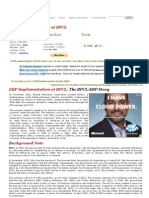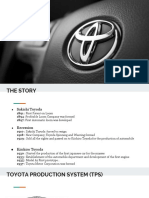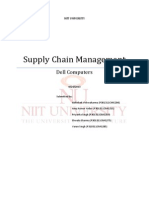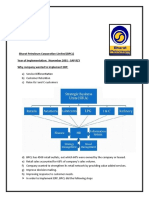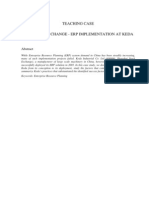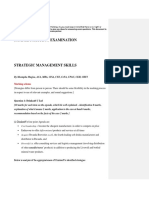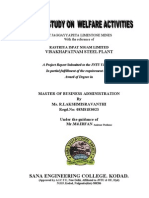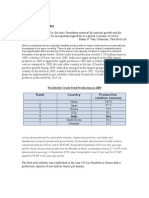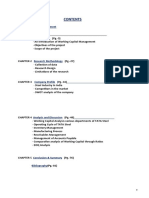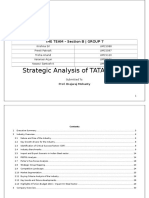Tisco Erp Case Study
Tisco Erp Case Study
Uploaded by
Pravin BajajCopyright:
Available Formats
Tisco Erp Case Study
Tisco Erp Case Study
Uploaded by
Pravin BajajCopyright
Available Formats
Share this document
Did you find this document useful?
Is this content inappropriate?
Copyright:
Available Formats
Tisco Erp Case Study
Tisco Erp Case Study
Uploaded by
Pravin BajajCopyright:
Available Formats
An ERP and a steely resolution - Case Study Special - Network Magazine India
Page 1 of 2
Printer Friendly Version
WEB LINK - http://www.networkmagazineindia.com/200210/case5.shtml
Case Study Special: TISCOs ERP implementation
An ERP and a steely resolution
Tata Iron and Steel Company Limited (TISCO) made a steely resolution to remodel itself from a product-driven to a customer-driven enterprise of the Internet economy. It deployed an ERP, SAP R/3 to help its resolution bear fruit, and now enjoys exciting operational and cost benefits. by Bhavish Sood "Post the introduction of the ERP solution, the results have been terrific. Tisco has spent close to Rs 40 crore on its implementation and has saved Rs 33 crore within a few months," said Ramesh C. Nadrajog, Vice President, Finance. "The manpower cost has reduced from over $200 per ton two years ago, to about $140 per ton in 2000. The overdue outstanding has been brought down from Rs 5,170 million in 1999 to Rs 4,033 million by June 2000. The inventory carrying cost has drastically deflated from Rs 190 per ton to Rs 155 per ton. To add to this, there have been significant costs savings through management of resources with the implementation of SAP." Sounds almost Utopian doesn't it? But that's exactly the result of TISCO's ERP implementation completed within eight months. TISCO is Asia's first and India's largest integrated private sector steel company. It has a state-of-the-art 3.5 million tonne steel plant and is capable of meeting the most rigorous demands of its customers worldwide. The company adopted ERP technology to take a lead in the competitive steel industry and through constant learning, innovation and refinement of its business operations, has transited seamlessly from a production-driven company to a customer-driven one. The existing technology was a simple replication of the manual system. Not only did it operate as individual islands of information but the technology had outlived its lifetime and was completely obsolete. The employees and management at TISCO faced a cumbersome task exchanging and retrieving information from the system. Further, the reliability of information obtained was questionable because of inconsistency and duplication of data from different departments. Also there was no built-in integrity check for various data sources. Besides, several times the information against certain items was found missing. An early response Responding to changing customer needs started as early as 1991, with a study on cost competitiveness and a formal business plan, followed by ISO 9002 certification and benchmarking initiatives. Realizing the need to further support the re-engineered core processes and quickly align the business processes to radical changes in the market place, TISCO decided to go for a new robust solution. In a Nutshell
The Company TISCO is Asia's first and India's largest integrated private sector steel company. It is present in 46 nationwide locations. The Need The company wanted to keep its lead in the competitive steel industry through constant learning, innovation, and refinement of its business operations. It had to transit from a production-driven company to a customer-driven one. The legacy systems had outlived its life and was quite obsolete. The Solution An ERP SAP R/3 was deployed in a 'big bang' approach across all its locations nationwide. The Benefits The company now has efficient business processes, enhanced customer service, reduced costs, improved productivity, accelerated transaction time, workflow management and reduction in the number of credit management errors. There have also been significant savings in manpower, inventory
levels, and resources. Design In 1998-99 a small cross-functional in-house team along with consultants from Arthur D. Little (Strategy Consultants) and IBM Global Services (BPR Consultants) redesigned the two core business processes: Order Generation & Fulfillment and the Marketing Development processes. This was done to improve customer focus, facilitating better credit control, and reduction of stocks.
Choosing the platform and technology The management at TISCO wanted the software to seamlessly integrate with its existing information system and further provide compatibility with its future implementations. After an in-depth study of functionality, cost, time, compatibility, esteem, operability, support, and future organizational requirements SAP fared on the top of the list of contenders. The implementation of SAP was associated with certain strategic goals in mind. With this implementation, TISCO wanted to bring forth a culture of continuous learning and change.
http://www.expresscomputeronline.com/cgi-bin/ecprint/MasterPFP.cgi?doc=
16/10/2011
An ERP and a steely resolution - Case Study Special - Network Magazine India
Page 2 of 2
This would enable TISCO to achieve a world-class status for its products and services and strengthen its leadership position in the industry. Besides this, TISCO also wanted the software to result in quick decision-making, transparency, credibility of data, and improve responsiveness to customers across all areas. The real challenge B Muthuraman, MD (Designate), said, "Implementing any ERP system is a challenge for an organization because of the declining success rate of ERP implementations world-wide. At Tata Steel however the real challenge for us did not lie in successfully implementing SAP or in rolling it out to our 46-odd geographic locations across the country under a big bang approach in just eight months. The real challenge lay ahead in building a conducive environment where SAP will be embedded in the hearts and minds of the people and the customers of TISCO." Mapping technology to business processes A road map was created to achieve the desired levels of success with ERP. All branches which had huge numbers of transactions and complexity, were identified as 'hubs.' And the smaller branches along with the consignment agents were defined as 'spokes,' which were attached to these branches. In January 1999 TISCO created a team called 'TEAM ASSET', an acronym for Achieve Success through SAP Enabled Transformation. The TEAM ASSET had two simple axioms: Go-Live date - 1st November 1999 There are only 24 hours a day Preparatory task forces activities were conducted and core business processes were mapped to SAP modules. A parallel activity called 'Change Management' was initiated within the company. The prime objective of 'Change Management' was to reach out to people involved non-directly in the project to apprise them of the developments taking place. Tata Steel planned a 'big-bang' approach of going live with all the modules at the same time. Within eight months, on November 01, 1999, Tata Steel pulled off a big bang implementation of all SAP modules at one go across 46 countrywide locations. The deadline was successfully met. The Result The introduction of SAP solutions within Tata Steel has led to efficient business processes, enhanced customer service, reduced costs, improved productivity, accelerated transaction time, workflow management and reduction in the number of credit management errors. There have also been significant savings in manpower, inventory levels, and resource management. TISCO can now update its customers daily and provide seamless services across the country, improving customer management. The availability of online information has facilitated quicker and reliable trend analysis for efficient decision-making. Besides, the streamlined business process reduces the levels of legacy system and also provides consistent business practices across locations and excellent audit trail of all transactions. "Now I shudder to think how we were functioning so many years without a world-renowned ERP system. Along with the hard times we had, came the rewards of the success of implementation," remarked Mr. K. V. Srinivasan, Member, Team ASSET at TISCO.
Bhavish Sood can be reached at bhavishsood@netscape.net
http://www.expresscomputeronline.com/cgi-bin/ecprint/MasterPFP.cgi?doc=
16/10/2011
You might also like
- Industry 4 With SapDocument44 pagesIndustry 4 With SapSuvendu BishoyiNo ratings yet
- Gbi Bikes Final ProjectDocument37 pagesGbi Bikes Final Projectapi-489545250No ratings yet
- Supply Chain Management at Nestle IndiaDocument2 pagesSupply Chain Management at Nestle IndiaTEJAS SURYAVANSHINo ratings yet
- Global Auto The ERP Implementation ProjectDocument15 pagesGlobal Auto The ERP Implementation ProjectYosilu AvilaNo ratings yet
- DellDocument7 pagesDellJune SueNo ratings yet
- ERP Implementation at BPCL - Free Case Studies - Case Study DownloadDocument2 pagesERP Implementation at BPCL - Free Case Studies - Case Study DownloadDharmesh Kumar GautamNo ratings yet
- Economics Case Study (Demand Forecasting)Document4 pagesEconomics Case Study (Demand Forecasting)Abhinav SinghNo ratings yet
- E-Business Model of CitiBankDocument1 pageE-Business Model of CitiBankKnt Nallasamy GounderNo ratings yet
- Sony ERP PresentationDocument16 pagesSony ERP PresentationVaishak M Gowda50% (2)
- Strategic Management Case Studies 4th Sem MBADocument7 pagesStrategic Management Case Studies 4th Sem MBAdhanush67% (6)
- Erp in Tata MotorsDocument3 pagesErp in Tata Motorslakshmibabymani100% (1)
- Bennett's Machine ShopDocument18 pagesBennett's Machine ShopAnith Zahirah100% (2)
- MIS Case 2 - Group 8 - Frito-LayDocument2 pagesMIS Case 2 - Group 8 - Frito-Layv100% (1)
- Asian PaintsDocument16 pagesAsian PaintsashNo ratings yet
- Nestle USA ERP ImplementationDocument11 pagesNestle USA ERP ImplementationIrawan PrastomoNo ratings yet
- Study of SapDocument94 pagesStudy of SapUjjwal KaushikNo ratings yet
- PepsicoDocument23 pagesPepsicoAshutosh MishraNo ratings yet
- Baan ERP HistoryDocument18 pagesBaan ERP HistoryBalaji_SAPNo ratings yet
- Harman Speakers On Tata Tiago and Its Future Marketing Strategy For India/ Asia Pacific RegionDocument7 pagesHarman Speakers On Tata Tiago and Its Future Marketing Strategy For India/ Asia Pacific RegionPreeti SoniNo ratings yet
- Marico Industries SAP - Group 3Document16 pagesMarico Industries SAP - Group 3pb_vgsl100% (1)
- Course: Operations Management Code: OPM 202 Case: Lenovo Student Name: Professor Name: Date: 11/16/2021Document14 pagesCourse: Operations Management Code: OPM 202 Case: Lenovo Student Name: Professor Name: Date: 11/16/2021rabia basriNo ratings yet
- BBA CAT-1 Question Paper - B2BDocument2 pagesBBA CAT-1 Question Paper - B2BGowthamanNo ratings yet
- DellDocument38 pagesDellMishra SukeshNo ratings yet
- Hero Honda CRM Strategies PrintDocument8 pagesHero Honda CRM Strategies PrintPrashant100% (1)
- MRFDocument6 pagesMRFDebottam SahaNo ratings yet
- Platform PlanetDocument104 pagesPlatform PlanetDaniel PerseguimNo ratings yet
- Boeing's Global StrategiesDocument12 pagesBoeing's Global StrategiesPeter Mulwa100% (1)
- New Product DevelopmentDocument13 pagesNew Product DevelopmentIAEME PublicationNo ratings yet
- Benefits of ERP Implementation On VW GroupDocument22 pagesBenefits of ERP Implementation On VW GroupMuntazir Haider100% (8)
- Case Study 3: Starbucks Corporation: Building A Sustainable Supply ChainDocument5 pagesCase Study 3: Starbucks Corporation: Building A Sustainable Supply Chainneha reddyNo ratings yet
- Toyota PresentationDocument13 pagesToyota PresentationShanoonNo ratings yet
- HPCLDocument8 pagesHPCLabhipsa_dashNo ratings yet
- Supply Chain Management-DellDocument26 pagesSupply Chain Management-DellGajananNo ratings yet
- Intro ERP Using GBI Exercises SD en v3.1 PDFDocument13 pagesIntro ERP Using GBI Exercises SD en v3.1 PDFShubhamOmerNo ratings yet
- NikeDocument14 pagesNikeMurtaza ShaikhNo ratings yet
- Dell Marketing StrategiesDocument14 pagesDell Marketing StrategiessatipradeepakNo ratings yet
- A Stakeholder Approach and Business EthicsDocument16 pagesA Stakeholder Approach and Business EthicsLiora Claire AngelicaNo ratings yet
- Business Pitch DeckDocument1 pageBusiness Pitch DeckvictorNo ratings yet
- Tesco AnswersDocument3 pagesTesco AnswerskunalNo ratings yet
- "A Study of Customer Satisfaction Towards Car Rental Services Provided by MayflowerDocument6 pages"A Study of Customer Satisfaction Towards Car Rental Services Provided by MayflowerChiaki Hidayah100% (1)
- Flextronics CaseDocument3 pagesFlextronics CaseAnukriti ShakyawarNo ratings yet
- Flipkart InitialDocument9 pagesFlipkart InitialIshan BhatiaNo ratings yet
- Group 8 Section A - Shoe Corporation of Illinois CaseDocument2 pagesGroup 8 Section A - Shoe Corporation of Illinois CaseSuchita SuryanarayananNo ratings yet
- Role of Management Information System in Tata MotorsDocument13 pagesRole of Management Information System in Tata MotorsPrasanna Dhanasekaran0% (1)
- Southfield Packaging Updated Case Study FinalDocument6 pagesSouthfield Packaging Updated Case Study FinalAngel BurkeNo ratings yet
- ERP System in ArongDocument7 pagesERP System in ArongthreeinvestigatorsNo ratings yet
- Project Report: CRM-An OverviewDocument45 pagesProject Report: CRM-An OverviewDevelopers Community YouTube ChannelNo ratings yet
- Sap Case StudyDocument2 pagesSap Case StudyAnjali Lakra100% (1)
- ERP - Unit 1Document12 pagesERP - Unit 1Karthick JayaramanNo ratings yet
- Bharat Petroleum Corporation Limited (BPCL) Year of Implementation: November 2001 - SAP R/3 Why Company Wanted To Implement ERPDocument4 pagesBharat Petroleum Corporation Limited (BPCL) Year of Implementation: November 2001 - SAP R/3 Why Company Wanted To Implement ERPRohit CharpeNo ratings yet
- Keda ERP Implementation Case SolutionDocument12 pagesKeda ERP Implementation Case SolutionPraveen Kumar67% (3)
- Management Information System in Apple IncDocument14 pagesManagement Information System in Apple IncBilahari P GNo ratings yet
- Prowess BasicsDocument18 pagesProwess Basicspathakak1982No ratings yet
- MBA Strategy Exam - Detailed Answer MarkingDocument21 pagesMBA Strategy Exam - Detailed Answer MarkingMuse ManiaNo ratings yet
- ToyotaDocument10 pagesToyotaArun Sanal100% (2)
- Financial Accounting - Accounts Receivable (FI - AR) : Product Motivation PrerequisitesDocument45 pagesFinancial Accounting - Accounts Receivable (FI - AR) : Product Motivation PrerequisitesTuệ Nguyễn Ngọc GiaNo ratings yet
- Form No.: 0354: 1 October 28, 2020 11:30 PMDocument4 pagesForm No.: 0354: 1 October 28, 2020 11:30 PMavismile111No ratings yet
- Tata-Corus: Dr. Manisha DhirDocument14 pagesTata-Corus: Dr. Manisha DhirManisha DhirNo ratings yet
- Swot Analysis of Tata SteelDocument11 pagesSwot Analysis of Tata Steelkausysnitdgp458283% (6)
- Export Report of Tata SteelDocument4 pagesExport Report of Tata SteelHarshadNo ratings yet
- Contract Labour Management at Tata Steel: Master of Business AdministrationDocument58 pagesContract Labour Management at Tata Steel: Master of Business AdministrationShamikaNo ratings yet
- G8 Weavers Iron SmeltersDocument33 pagesG8 Weavers Iron SmeltersSonia71% (7)
- ABM, TATA, Boeing, GENERACDocument4 pagesABM, TATA, Boeing, GENERACkudukachiNo ratings yet
- Financial Accounting Project: TATA Steel Ltd. JSW Steel LTDDocument17 pagesFinancial Accounting Project: TATA Steel Ltd. JSW Steel LTDSanju VisuNo ratings yet
- Tata Steel Industrial by Product PDFDocument33 pagesTata Steel Industrial by Product PDFJay ShuklaNo ratings yet
- Indian Economy On The Eve of IndependenceDocument71 pagesIndian Economy On The Eve of IndependenceAnne GulatiNo ratings yet
- WTT - CKPD 2022Document182 pagesWTT - CKPD 2022SantanuPradhanNo ratings yet
- Basic Scheme of The CST Act - The Basic Scheme of The CST Act Is AsDocument43 pagesBasic Scheme of The CST Act - The Basic Scheme of The CST Act Is AsShipra JoshiNo ratings yet
- Welfare ActivitiesDocument112 pagesWelfare ActivitiesSathuluri Sambasiva RaoNo ratings yet
- Fundamental Analysis of Iron and Steel Industry and Tata Steel IndiabullsDocument75 pagesFundamental Analysis of Iron and Steel Industry and Tata Steel IndiabullsCHIRAG JAIN 1823614No ratings yet
- TATA Group-BCG AnalysisDocument18 pagesTATA Group-BCG AnalysisParveen Rathee100% (6)
- Executive Summary The Indian Steel Industry: Worldwide Crude Steel Production in 2009Document6 pagesExecutive Summary The Indian Steel Industry: Worldwide Crude Steel Production in 2009Prateek Singh SidhuNo ratings yet
- Tata Steel Corporate Brochure 2019 20Document35 pagesTata Steel Corporate Brochure 2019 20Ranjit YadavNo ratings yet
- A Mass of Anomalies Land Law and Sovereignty in An Indian Company TownComparative Studies in Society and HistoryDocument23 pagesA Mass of Anomalies Land Law and Sovereignty in An Indian Company TownComparative Studies in Society and HistoryArqacNo ratings yet
- Investor Presentation July 2011Document31 pagesInvestor Presentation July 2011subudaniNo ratings yet
- Working Capital Management (TATA STEEL)Document79 pagesWorking Capital Management (TATA STEEL)Abhaydeep Kumar Jha60% (10)
- (All Column Values) (All Column Values) 72101200 (All Column Values) (All Column Values) Between 07/27/2024 - 10/27/2024Document7 pages(All Column Values) (All Column Values) 72101200 (All Column Values) (All Column Values) Between 07/27/2024 - 10/27/2024মো.শাহাদাত হোসেন সোহাগNo ratings yet
- Project On: Relaibility Improvement of Chain Conveyor at Battery 5,6 & 7 TSL (India)Document8 pagesProject On: Relaibility Improvement of Chain Conveyor at Battery 5,6 & 7 TSL (India)saurabh kumarNo ratings yet
- Accounts - TATA GroupDocument66 pagesAccounts - TATA Groupluvjandial100% (1)
- Corporate Accounting Mergers and Amalgamation CIA-1 Company: Tata Steel and CorusDocument11 pagesCorporate Accounting Mergers and Amalgamation CIA-1 Company: Tata Steel and CorusDhanushMohanNo ratings yet
- BUS 323C Case Analysis - The Last Rajah (Latest)Document14 pagesBUS 323C Case Analysis - The Last Rajah (Latest)Carol TanNo ratings yet
- DLSDocument7 pagesDLSanees bhaiNo ratings yet
- Internship ReportDocument117 pagesInternship ReportMeghaa Dasari100% (1)
- A Study On Risk and Return Analysis of Listed Stocks in Sensex With Special Reference To Bombay Stock ExchangeDocument83 pagesA Study On Risk and Return Analysis of Listed Stocks in Sensex With Special Reference To Bombay Stock ExchangeVRameshram50% (8)
- STM TataSteel Group7 SectionBDocument53 pagesSTM TataSteel Group7 SectionBSiddharth Sharma100% (1)





